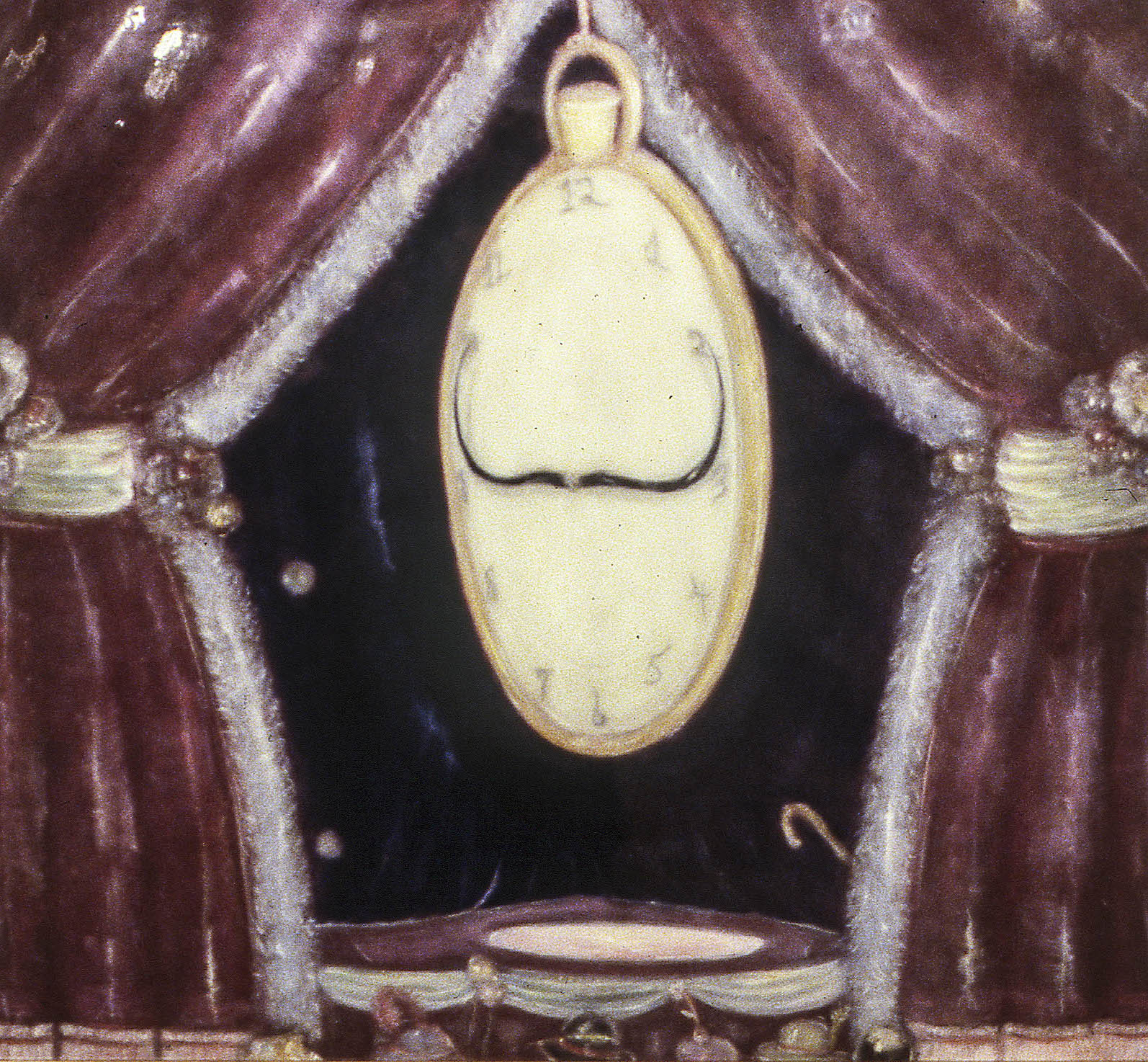
Janet McKiernan's Magic Theater
October 16 - December 12, 1987
The crystalline surfaces of Janet McKiernan’s paintings bring to mind the reflections in a sorcerer’s pool, beneath which stirs a spring of magical imagery. Innocence swims below the surface, coupling and uncoupling with wit and perversity. The disquieting quality of many of the paintings results from a fusion of a child’s mimetic mind with a distanced, somewhat cynical outlook.
McKiernan’s work has all the delicacy and whimsy of a Faberge egg; whipped cream clouds, lacy ribbons of chimney smoke and ingenuous bluebirds skim across the skies of her landscapes. In The Intangible, a bird poised in a pale pink sky “plucked” smoke, which is thus transformed into cotton, from a brick chimney. On the one hand, we have a paradigm of the artist’s alchemical role: mixed colors from tubes of paint transforming them through application to the canvas, thus creating a world with its own set of rules and illusions. On the other hand, and perhaps more importantly, by making smoke palpable, McKiernan attests to the converse – that what we call reality is as diaphanous as smoke rings in the air.
In McKiernan’s paintings, humans are often indifferent spectators to the sly animation of everyday objects. In The Shell Game, a man with pale skin, slicked back hair and an elongated nose removed his hat to reveal a spinning top on his head. With an expression as blank as a character in an animated store window display, the wheels of thought had literally escaped his head, leaving him cipher.
In spite of their veneer of fairy tale pleasantry, these paintings hold the concealed intentions of an encoded diary, conjuring notions of Rasputin in Toyland. As a counterpoint to her juxtaposition of innocence and the darker subconscious, McKiernan’s palette balances a range of pastel pinks, yellows, and greens with engorged purples and reds. She will dress her windows and skies with chaste, sheer lace or engulf them in heavy velvets trimmed with ermine and peppered with tassels and jewels of paint, suitable for a spoiled Czar.
Many of the paintings feature the device of a half-drawn curtain, as in a carnival sideshow, seducing the viewer with a promise of a revelation of wonders, a defiance of the laws of nature. Before our very eyes, a clown juggles weightless bubbles and feathers. An egg hatches endlessly to reveal yet another egg within, presenting us with an ersatz immaculate conception. A steaming teapot metamorphoses into the head of an elephant.
Masquerading as fleshy grapes, eyeballs clustered on a plate tempted us to sample their sweet pulp – a mordant reply to the expression “painting is a feast for the eyes.” We are further mystified by the frequent and unexplained presence of a stratum of floating, translucent bubbles which drifted aimlessly through the tableaux, as if linking each unique scenario to the next.
But, like the carnival magician, McKiernan is careful not to reveal too much. With faint insinuations of surreality lurking behind every rock, every cloud, every tree, her paintings stop short of being graphically surreal. She parodies the Surrealist showman who lacked such restraint in Dolly. In this work, a gigantic Dali- mustachioed watch face, suspended from a parted curtain, looms above the dwarfed audience. As in any vaudeville act, we are reminded that the proverbial cane is always waiting in the wings to remove a poor player who has outworn his welcome on the stage. The Persistence of Memory is reduced to the Persistence of Dali.
I pursue the grasp of surreal mental twisters…Calculated to extend limits of perception and entice subconscious connections to the surface, the usual and familiar are exposed as ravishingly, thrillingly absurd.*
Entering McKiernan’s veiled worlds is like stepping inside the “Magic Theater” in Herman Hesse’s Steppenwolf, where any transformation is possible and all dreams may come true. As in Steppenwolf, admission is NOT FOR EVERBODY – a superficial view will not disclose the images’ darker purpose. The most insidious nightmare, after all, is one that poses as a detached parade of mundane objects and activities, building gradually toward the dreamer’s unaccountable experience of anxiety. The price of admittance to her “theater” is no steeper than a subtle rearrangement of our perceptions regarding the decorousness of the commonplace.
-Barry Blinderman and Laurie Dahlberg
*Excerpt from the artist’s statement, 1985
Exhibition Documentation
Events & Programming
Exhibition reception
October 16, 1987
5:00 p.m. - 7:00 p.m.
